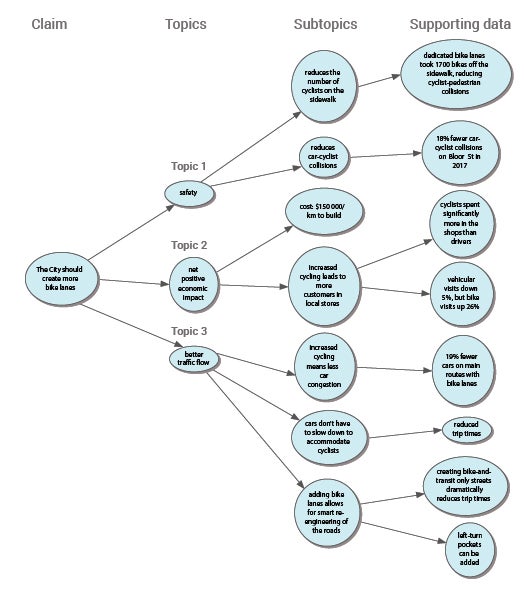During the writing process, an outline provides the writer an organizational (and often visual) guide to how ideas should be presented in the paper to provide a strong, clear, and logical argument. Below are two types of outlines you can create: linear and graphic.
Linear Outlines
The outline below shows how you can divide your argument into a main claim, and then different subtopics based on the main claim. Once you have organized all of your subtopics, you can then organize your evidence for your claim.
Claim: The City should create more bike lanes
- Topic 1: Safety
- Subtopic: reduces the number of cyclists on the sidewalk
- Supporting data: dedicated bike lanes took 1700 bikes off the sidewalk, reducing cyclist pedestrian collisions
- Subtopic: reduces car-cyclist collisions
- Supporting data: 18% fewer car-cyclist collisions on Bloor St. in 2017
- Subtopic: reduces the number of cyclists on the sidewalk
- Topic 2: Net positive economic impact
- Subtopic: cost: $150 000/km to build
- Subtopic: increased cycling leads to more customers in local stores
- Supporting data 1: vehicular visits down 5%, but bike visits up 26%
- Supporting data 2: cyclists spent significantly more in the shops than drivers
- Topic 3: Better traffic flow
- Subtopic: increased cycling means less car congestion
- Supporting data: 19% fewer cars on main routes with bike lanes
- Subtopic: cars don't have to slow down to accommodate cyclists
- Supporting data: reduced trip times
- Subtopic: adding bike lanes allows for smart re-engineering of the roads
- Supporting data 1: left-turn pockets can be added
- Supporting data 2: creating bike-and-transit only streets dramatically reduces trip times
- Subtopic: increased cycling means less car congestion
Graphic Outlines
Graphic outlines are a more visual way to represent material for your paper. Rather than relying on terms like topic, subtopic, and supporting data to organize your information, you arrange ideas into different "levels" by using larger or smaller shapes. For example, the main claim might be a very large circle, the three topics would then be slightly smaller circles, and the subtopics, even smaller circles.

Arranging Your Arguments
As you are developing an outline for your particular argument, consider the following guidelines:
- Some arguments may rely on information presented in a previous section. In other words, you may need to prove A before you can explain B.
- It is common to put your strongest argument last.
- Sometimes it makes sense to present information chronologically.
- You may have to reorder your points several times during the writing process.